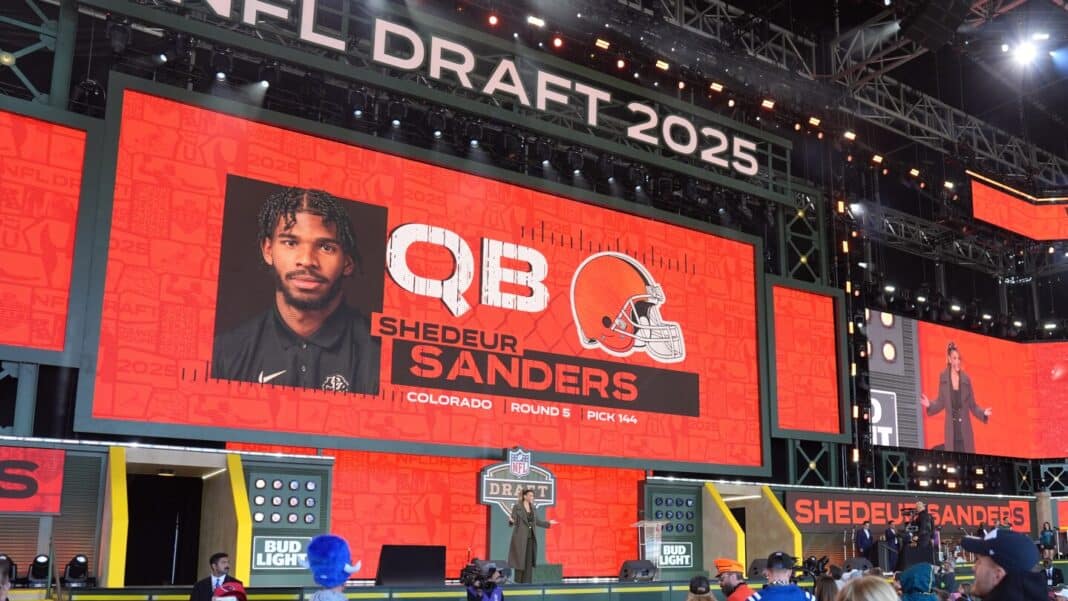The 2025 NFL Draft might go down as one of the most strategic and surprising drafts we’ve seen in years. Front offices came in clearly with a plan—and they stuck to it, no matter how much it rattled fans or shook up mock drafts. When the dust settled after three days in Green Bay, we were left with storylines that few could have predicted and player selections that defied conventional wisdom across the board.
The Draft: Unprecedented Fall of a Future Star
Let’s start with the headline: Shedeur Sanders fell all the way to the fifth round. That’s not a typo. Once projected as a potential second-rounder (and even first in some circles), Shedeur’s slide was the topic of night one, two, and for a part of three. From a pure football perspective, sure, there were knocks—his sack rate, decision-making under duress—, and the talent in his conference but his leadership, arm talent, and football IQ were undeniable.
So why the fall?
It feels like teams weren’t just evaluating the quarterback—they were evaluating the entire package: the social media presence, the famous last name, the influence of Coach Prime. Some organizations might’ve seen that as a media circus waiting to happen. Others? Just didn’t want the pressure. But the fifth round? That feels excessive.
The Cleveland Browns finally ended the slide by trading up to select Sanders with the 144th pick. Remarkably, this came after the Browns had already drafted Oregon quarterback Dillon Gabriel in the third round, signaling a complete overhaul of their quarterback room. Browns GM Andrew Berry described Sanders as “a highly accurate pocket passer who does a good job of taking care of the ball,” suggesting they saw tremendous value that other teams somehow missed.
The Quarterback Carousel
While Sanders dominated the headlines, the quarterback selection story went far beyond his surprising fall. Five signal-callers were selected before him, each representing different organizational philosophies. Miami’s Cam Ward went first overall to the Titans, followed by Ole Miss’s Jaxson Dart to the Giants at 25. The Saints surprised many by taking Louisville’s Tyler Shough in the second round—a 25-year-old prospect with promise but a concerning injury history.
In the third round, Seattle grabbed Alabama’s Jalen Milroe, an athletic dual-threat option with tremendous upside. Then came the Browns’ selection of Gabriel before they doubled down with Sanders two rounds later. This quarterback class showcased how differently teams evaluate the position—some prioritizing immediate readiness, others betting on athletic upside, and a few (like Cleveland) hedging their bets with multiple selections.
The reaction to Sanders’ fall reached beyond, with even former President Donald Trump weighing in, questioning NFL owners’ decision-making. Sanders himself simply tweeted as Round 3 concluded, adding what he later called “fuel to the fire.”
The New Draft Philosophy
Outside of Shedeur, the draft felt like a chess match. Teams were calculated, and some of the biggest moves came from franchises you’d least expect. Picks that looked questionable on paper had logic behind them once you zoomed out. It wasn’t about hype—it was about fit, system, and long-term play.
This era of analytics and specialized coaching schemes has transformed the draft from a “best player available” approach to something more nuanced. Teams like the Detroit Lions and Baltimore Ravens continued their pattern of drafting specifically for their systems, sometimes passing on higher-rated prospects for players who better fit their vision. Meanwhile, the Kansas City Chiefs focused on complementary pieces to maintain their championship window, rather than swinging for the fences.
My takeaway? This draft was about control. Teams wanted guys who fit their vision, their locker room, and their vibe. Not just talent, but culture fits. That’s why it shocked us—because it wasn’t about what we thought was best. It was about what they thought was sustainable for long-term success.
One thing’s for sure: this class is going to be remembered. Whether it’s for its brilliance or its blind spots, only time will tell. But the story of Shedeur Sanders—from potential first-rounder to fifth-round selection—will serve as a fascinating case study in draft evaluation for years to come. Sometimes the most valuable picks aren’t the ones that make headlines on day one, but the ones that prove everyone wrong on Sundays.




